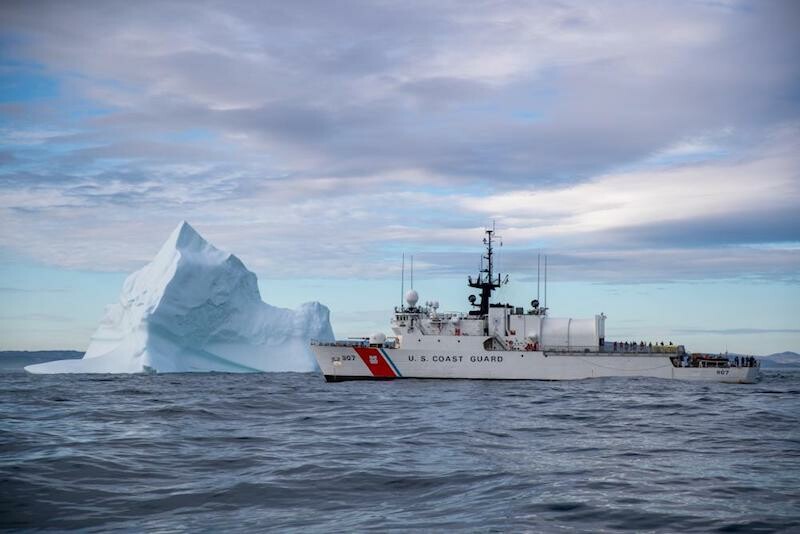Strengthening partnerships and testing interoperability, the USCGC Escanaba (WMEC 907) and USCGC Richard Snyder (WPC 1127) participated in Operation Nanook in early to mid-August.
Operation Nanook is the Canadian Armed Forces' signature Arctic operation, comprising a series of comprehensive, joint, interagency, and multinational activities designed to exercise the defense of Canada and security in the region and incident management response and search rescue capabilities.
With commercial traffic and cruise ships increasingly visible in the Arctic, international collaborations are necessary to meet this increased traffic's potential search and rescue challenge. Nanook-Tuugaalik is the maritime component of the Nanook series of deployments and training events intended to be an Arctic naval presence operation and domain awareness of the waters in and around Baffin Bay and Davis Strait. Nanook-Tatigiit is the incident management and search and rescue exercise portion.
"We had excellent training with the crews of HMCS Harry Dewolf (AOPV 430), HMCS Goose Bay (MM 707), and Richard Snyder. The joint effort during Tuugaalik and Tatigiit included multi-ship small boat training, formation steaming, hailing and signals exercises, and more. Weather, especially in the Arctic, is a genuine consideration, and increasing sea state and fog tested us," said Cmdr. Ben Spector, the commanding officer of Escanaba. "The U.S. Coast Guard remains committed to conducting operations and combined maritime exercises throughout the Atlantic and the Arctic region, ensuring mission capacity and future force readiness. Training with our partners and allied nations ensure all countries are ready, relevant, and responsive in an ever-evolving maritime environment.”
The operation is also the first time the U.S. Coast Guard deployed a 154' Sentinel-class fast response cutter to the region — USCGC Richard Snyder. As the inventory of FRCs grows, the U.S. Coast Guard continues to test the full range of their capability, including operations in high latitude environments. While these ships are not ice-strengthened, units observed mitigations, such as the deployment time of year and carefully considering operating areas.
"The FRC has fared exceedingly well in the Arctic. Our major concerns were fuel and food, and there have been no issues with either as the cutter continues to steam through the operational area and complete all training and interactions with stellar results," said Lt. Cmdr. Gregory Bredariol, the commanding officer of Richard Snyder. "We've done some once-in-a-lifetime activities including Fjords transits, getting close aboard icebergs much larger than the cutter; restricted waters transits in harsh conditions and deployment to an unfamiliar but mission-critical area. Our colleagues aboard the Escanaba were critical in our deployment, assisting with logistics and operational support. I can't express enough our appreciation as we deployed far from our normal operations area and completed mission sets that we don't generally practice. As a cutter based in Atlantic Beach, North Carolina, we primarily focus on living marine resources and search and rescue.”
Following Nanook, both ship's crews are conducting engagements and resupplying in Nuuk, Greenland. Snyder will return home. Escanaba will transition to support Frontier Sentinel, an annual exercise between the U.S. Coast Guard, U.S. Navy, and Royal Canadian Navy, ensuring the ability of the Tri-Party Staff and tactical assets to work together. This year's live exercise uses feedback from the prior year's tabletop discussion.
Participants in all exercises are observing Covid-19 protocols to mitigate exposure and comply with host nation guidelines. Exercise scenarios took into account Covid restrictions and respective realities.
Operation Nanook is the third of four major deployments of the U.S. Coast Guard's Atlantic Arctic Season. In June, the USCGC Eagle (WIX 327) visited Iceland, where Vice Adm. Steven Poulin, the Atlantic Area commander, hosted Icelandic officials for Arctic discussions. Also, in June, the USCGC Maple (WLB 207) participated in the Danish Joint Arctic Command's annual exercise, Ex Argus, in Southern Greenland with international partners. Later this fall, the USCGC Healy (WAGB 20) will make stops along the U.S. East Coast after transiting the Northwest Passage on their circumnavigation of North America.
Operation Nanook has been held annually since its inception over a decade ago. Last year's exercise was scaled down due to the Covid-19 pandemic. While participants could not conduct port visits, the activity focused on naval readiness, ship tracking, and gunnery operations between multinational partners, including the U.S., Canada, Denmark, and France. The U.S. sent the USCGC Tahoma (WMEC 908) and USCGC Campbell (WMEC 909) to participate.
USCGC Escanaba is a 270' Famous-class medium endurance cutter with a crew of about 100 operating for the U.S. Coast Guard Atlantic Area. USCGC Richard Snyder is a Fifth Coast Guard District 154' Sentinel-class fast response cutter with a crew of about 24 also operating for U.S. Coast Guard Atlantic Area. The Atlantic Area commander and staff oversee all Coast Guard domestic operations east of the Rocky Mountains, including the Arctic, Caribbean, and Southern Atlantic and Coast Guard out-of-hemisphere operations in Europe, Africa, and Southwest Asia.





